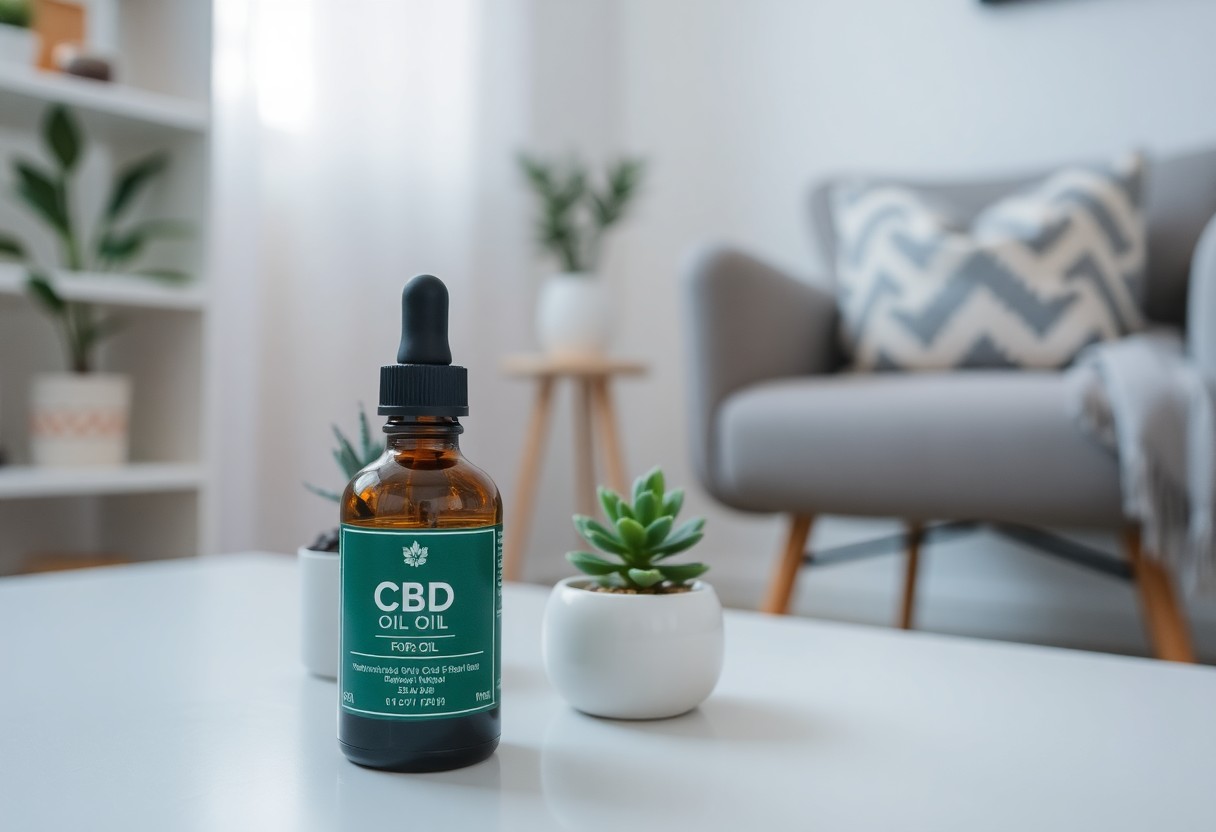5 Powerful Steps To Alleviate Pain Naturally With CBD

Over the years, cannabidiol (CBD) has gained significant attention for its potential to provide relief from various types of pain. If you struggle with discomfort and are searching for alternative methods to manage it, you can harness the natural benefits of CBD. This blog post will guide you through five powerful steps to incorporate CBD into your daily routine effectively, helping you alleviate pain without the side effects commonly associated with conventional medications. Let’s explore how you can enhance your well-being and reclaim your comfort.
Key Takeaways:
- Understanding CBD: Familiarize yourself with how CBD interacts with the body’s endocannabinoid system to promote pain relief.
- Dosage Guidelines: Start with a low dose and gradually increase to find the optimal amount for managing pain.
- Different Forms: Explore various CBD products like oils, capsules, and topicals to find what works best for your needs.
- Quality Matters: Choose high-quality, third-party tested CBD products to ensure safety and efficacy.
- Holistic Approach: Combine CBD with other natural pain-relief techniques such as exercise, meditation, and dietary changes for enhanced results.
Understanding CBD and Its Benefits
As you explore the natural alternatives available for pain relief, it’s imperative to grasp what CBD is and how it can benefit you. CBD, or cannabidiol, is a compound derived from the cannabis plant, specifically from hemp. Unlike its more famous counterpart, THC (tetrahydrocannabinol), CBD does not produce a psychoactive effect, meaning it won’t make you feel “high.” This quality makes it a popular choice for those seeking the therapeutic benefits of cannabis without the altering effects that come with THC. As the stigma around cannabis subsides, more people, including researchers, are paying attention to CBD’s potential health benefits, especially for pain management, anxiety relief, and overall wellness.
What is CBD?
One of the main reasons for the growing interest in CBD is its ability to support various aspects of health. You may find CBD in various forms, from oils and tinctures to capsules, edibles, and topical products. Each method has its unique benefits and may deliver different effects based on how your body processes the compound. It’s worth noting that while CBD is often associated with therapeutic properties, it’s important to choose high-quality products and be aware of dosage considerations to ensure optimal results in your pain-relief journey.
How CBD Interacts with the Body
With a better understanding of what CBD is, you may wonder how it interacts with your body to provide its myriad benefits. CBD interacts with the endocannabinoid system (ECS) – a complex network of receptors found throughout your body that regulates various physiological processes such as pain, mood, and immune responses. When you consume CBD, it binds to these receptors, helping to enhance your body’s natural ability to maintain balance and homeostasis. By doing so, it can help modulate pain perception, reduce inflammation, and alleviate anxiety, making it a potentially effective option for those dealing with chronic pain and related conditions.
The effects of CBD on your endocannabinoid system can vary from person to person, influenced by factors such as your individual biology and the specific condition being addressed. Some individuals might experience rapid relief, while others may notice gradual improvements over time. Understanding these intricacies can further empower you to find a CBD approach that best suits your needs and preferences for natural pain management.
Identifying Different Types of Pain
If you want to effectively use CBD for pain management, it’s important to first identify the type of pain you are experiencing. Pain can manifest in various forms and recognizing the specific characteristics can guide your approach to treatment. Here are some common types of pain you may encounter:
- Neuropathic pain
- Muscle pain
- Joint pain
- Inflammatory pain
- Referred pain
Assume that understanding these different pain types will significantly enhance your ability to address your personal pain management needs. For more information on how CBD oil may help, check this article on CBD oil for pain management: Effects, benefits, and uses.
| Type of Pain | Description |
|---|---|
| Neuropathic Pain | Caused by nerve damage or dysfunction |
| Muscle Pain | Resulting from muscle strain or injury |
| Joint Pain | Often related to arthritis or injury |
| Inflammatory Pain | Triggered by swelling and irritation |
| Referred Pain | Pain felt in one part of the body due to an issue in another |
Chronic vs. Acute Pain
Below you will find distinctions between chronic and acute pain. Acute pain is typically short-lived and often the result of an injury or damage to your body. This pain serves a protective function and tends to subside as the underlying issue heals. Chronic pain, on the other hand, lasts longer, often persisting for months or even years beyond the expected recovery time. It may stem from conditions such as arthritis, fibromyalgia, or past injuries.
Recognizing whether your pain is acute or chronic is vital in determining the most effective treatment approach. Chronic pain may require a multi-faceted strategy, potentially including CBD for sustained relief, whereas acute pain may demand immediate, targeted interventions.
Common Conditions that Cause Pain
Along your journey to alleviate pain naturally, you may encounter various conditions that lead to discomfort. Some of the most prevalent conditions include arthritis, headaches, back pain, fibromyalgia, and neuropathy. Each of these ailments can lead to different sensations and intensities of pain, influencing how you might choose to manage it.
Considering your symptoms and the specific conditions that trigger your pain, you may find that CBD offers a versatile form of relief. Its anti-inflammatory properties could be beneficial for conditions like arthritis or fibromyalgia, while its neuroprotective effects may soothe neuropathic pain. Taking note of your individual experience will empower you to select the most suitable CBD application for your unique situation.
Step 1: Consulting a Healthcare Professional
To commence on your journey towards alleviating pain naturally with CBD, it’s crucial to first consult a healthcare professional. This step serves as the foundation for ensuring you manage your discomfort safely and effectively. A healthcare provider can help you understand the potential benefits and limitations of using CBD, as well as its interactions with other medications you may be taking. Their guidance can help you navigate the often complex landscape of pain management and ensure that you are making informed decisions tailored to your specific health conditions.
Importance of Professional Guidance
Below, you will find the significance of obtaining professional guidance when considering CBD for pain relief. Healthcare professionals are equipped with the knowledge to assess your medical history and evaluate your pain conditions comprehensively. They can provide personalized recommendations, ensuring that your choice to use CBD aligns with your overall health strategy and does not conflict with any existing treatments.
Questions to Ask Your Doctor
Professional consultations can be greatly beneficial when you approach them with informed questions about the use of CBD. Start by inquiring about whether CBD is appropriate for your specific type of pain. You may also want to ask about the recommended dosage, forms of CBD that may work best for you, and any potential side effects you might need to consider. Additionally, discussing your current medications and other supplements can help your healthcare provider evaluate any risks involved with introducing CBD into your regimen.
Guidance from your healthcare professional can direct you in the right path when it comes to utilizing CBD for pain relief. By asking the right questions, you empower yourself to make well-informed choices based on your health status and personal pain management goals. This proactive communication not only enhances your understanding of CBD but also reinforces a collaborative relationship with your medical provider, ultimately leading to more effective pain management strategies.
Step 2: Choosing the Right CBD Product
After understanding the benefits of CBD for alleviating pain, the next step is to choose the right product for your needs. With a myriad of options available on the market, it’s imperative to familiarize yourself with the different forms of CBD. Each form has its own advantages and can suit various lifestyles and preferences.
Different Forms of CBD
Against the backdrop of an expanding CBD market, you will find several forms of this cannabinoid. CBD oil remains one of the most popular choices due to its versatility and ease of use. Additionally, there are capsules, edibles, topicals, and even vape products, making it simpler to incorporate CBD into your daily routine. Each form can provide distinct benefits, so you will want to consider what aligns best with your lifestyle and pain management goals.
Factors to Consider When Selecting a Product
Around your quest to choose the perfect CBD product, a few factors can aid your decision-making process. First and foremost, the source and quality of the CBD are paramount. Look for products that are derived from organically grown hemp, as this ensures you are consuming a cleaner product. Moreover, third-party lab testing can provide you with vital transparency regarding the potency and purity of the CBD you are considering.
- Source of CBD (organic hemp, type of extraction)
- Third-party lab testing results
- Your personal health needs and preferences
- Form of CBD (oil, capsules, topicals, etc.)
Perceiving these factors as key components of your decision will ultimately lead you towards a more effective CBD experience.
With numerous brands and products available, it’s a good idea to take your time researching and comparing options. Consider customer reviews, and product pricing, and consult with healthcare professionals if necessary. This will provide you with the confidence needed to select the product that aligns with your specific pain relief goals and lifestyle choices.
- Product reviews and customer testimonials
- Dosage and strength of the CBD
- Pricing in relation to your budget
- Availability of full-spectrum, broad-spectrum, or isolate options
Perceiving these aspects will enhance your ability to confidently choose the ideal CBD product for your natural pain relief journey.
Step 3: Determining the Right Dosage
Now that you are becoming more comfortable with incorporating CBD into your pain management routine, the next step is to determine the right dosage for your needs. Finding the appropriate amount can be a bit challenging due to the individual variations in body chemistry and sensitivities to CBD. Therefore, it’s crucial to approach your dosage methodically and thoughtfully to ensure you reap the maximum benefits without experiencing undesired effects.
Starting Low and Going Slow
One effective approach to establishing a suitable CBD dosage is to start low and go slow. Begin with a minimal amount, such as 5-10 mg, and observe how your body responds over the course of several days. This gradual introduction allows you the opportunity to evaluate your tolerance and assess any improvements in pain levels or associated symptoms without overwhelming your system.
As you monitor your reaction, you can incrementally increase your dosage by 5 mg each week, if necessary. This method is particularly beneficial since everyone’s body reacts differently to CBD, and it lets you find the balance that best addresses your pain while minimizing any side effects.
Signs of Effective CBD Use
To identify if you are using CBD effectively, pay close attention to your body’s response. Key indicators of effective CBD use include a noticeable reduction in pain levels, improvements in overall mood and well-being, and a better quality of sleep. You should also notice fewer side effects, allowing you to maintain your daily routine with more energy and focus. If you find these signs are emerging, it’s likely that you are on the right track with your dosage.
Hence, maintaining a journal to track your dosage, pain levels, and any side effects can be incredibly helpful in this process. Documenting your experiences will not only provide clarity on what works best for you but can also assist in communicating your findings with healthcare professionals. Over time, this trajectory will enable you to establish a personalized CBD regimen that aligns well with your pain management goals. Recall, the journey may take some time, but patience and careful observation will pay off in finding your optimal dosage.
Step 4: Incorporating CBD into Your Routine
Many individuals seeking natural relief from pain find that incorporating CBD into their daily routine can be an effective way to experience its benefits consistently. To maximize the advantages, it’s important to establish a routine that suits your lifestyle and personal preferences. This can involve taking CBD at specific times throughout the day that align with your pain levels, sleep schedule, and overall wellness activities. Finding a rhythm that works for you is crucial; consider tracking your dosage and effects to see what timing yields the best outcomes for your unique situation.
Best Times to Take CBD
An ideal time to take CBD might depend on your specific pain triggers or daily patterns. For example, if your discomfort tends to peak during specific hours, taking your CBD in the morning or just before your pain typically escalates may help you stay ahead of the discomfort. Additionally, if you struggle with pain-related sleep disturbances, incorporating CBD into your nighttime routine could promote relaxation and improve your overall rest, potentially minimizing pain the following day.
Complementary Practices for Pain Relief
For a more holistic approach, integrating complementary practices alongside your CBD routine can significantly enhance your pain management efforts. Activities such as yoga, meditation, or cognitive-behavioral therapy can work in tandem with CBD to create a comprehensive strategy for alleviating pain naturally. These practices can foster mindfulness, reduce anxiety, and improve your mental well-being, all of which can contribute to a greater sense of control over your pain.
Step into a well-rounded regimen by exploring various complementary practices that resonate with you. Whether it’s incorporating gentle stretches or accessing guided relaxation techniques, enhancing your CBD use with these supportive activities can lead to a more profound sense of relief and balance. Holistic pain management allows you to not only address physical discomfort but also fosters resilience and emotional well-being, creating a harmonious path toward healing.
Summing up
Drawing together the insights shared in this guide, you now have five powerful steps to alleviate pain naturally using CBD. By understanding the benefits of CBD for pain relief, selecting high-quality products, determining the appropriate dosage, exploring various consumption methods, and tracking your progress, you can create a tailored approach to manage your discomfort effectively. Each step empowers you to harness the potential of CBD in a way that best fits your lifestyle and needs.
As you navigate this journey, it’s crucial to stay informed and consult with your healthcare provider, especially if you are on medication or have underlying health conditions. Keep in mind that discovering the most effective method for you may take some time, so be patient and attentive to how your body responds. With dedication and the right strategies, you can experience a more balanced and pain-free life with the natural aid of CBD.
FAQ
Q: What is CBD and how does it help alleviate pain?
A: CBD, or cannabidiol, is a natural compound found in the hemp plant. It interacts with the body’s endocannabinoid system, which plays a key role in regulating pain, mood, and inflammation. By influencing cannabinoid receptors, CBD can help reduce pain sensations and inflammation, providing a natural alternative for those seeking relief.
Q: What are the 5 powerful steps to use CBD for pain relief?
A: The five powerful steps include: 1) Assessing your pain level to identify the type of pain you experience; 2) Choosing the right CBD product (oils, capsules, topicals, etc.) that suits your needs; 3) Determining the proper dosage and gradually increasing it as necessary; 4) Incorporating other natural remedies, such as a balanced diet and exercise; and 5) Staying informed about your personal experiences and adjusting your approach accordingly.
Q: Are there any side effects of using CBD for pain relief?
A: Some individuals may experience mild side effects when using CBD, including dry mouth, fatigue, changes in appetite, and diarrhea. It is advisable to start with a low dosage and observe how your body responds. Always consult with a healthcare professional before starting any new treatment, especially if you have pre-existing conditions or are taking other medications.
Q: How long does it take for CBD to relieve pain?
A: The time it takes for CBD to alleviate pain can vary depending on the method of consumption. For instance, CBD oil taken sublingually may provide relief within 15 to 30 minutes, while capsules or edibles may take longer, approximately 1 to 2 hours. Topicals, when applied directly to the skin, usually start working in about 30 minutes but can vary based on the individual.
Q: Is it legal to use CBD for pain management?
A: The legality of CBD depends on the source and concentration. In many places, CBD derived from hemp (containing less than 0.3% THC) is legal. However, regulations can vary by country, state, or region, so it’s vital to check local laws and ensure that the product you choose complies with your area’s regulations.














